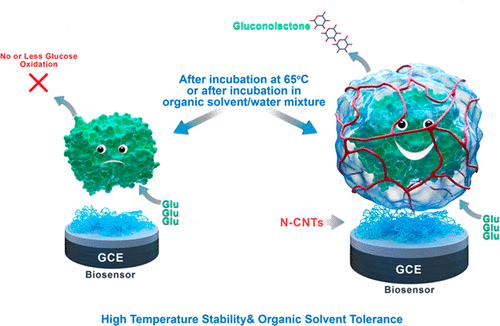当前位置:
X-MOL 学术
›
Anal. Chem.
›
论文详情
Our official English website, www.x-mol.net, welcomes your
feedback! (Note: you will need to create a separate account there.)
Robust Single-Molecule Enzyme Nanocapsules for Biosensing with Significantly Improved Biosensor Stability.
Analytical Chemistry ( IF 6.7 ) Pub Date : 2020-03-31 , DOI: 10.1021/acs.analchem.9b05466 Dhanjai 1 , Xianbo Lu 1 , Lingxia Wu 1 , Jiping Chen 1 , Yunfeng Lu 2
Analytical Chemistry ( IF 6.7 ) Pub Date : 2020-03-31 , DOI: 10.1021/acs.analchem.9b05466 Dhanjai 1 , Xianbo Lu 1 , Lingxia Wu 1 , Jiping Chen 1 , Yunfeng Lu 2
Affiliation

|
The present study demonstrates the use of highly stable single-molecule enzyme nanocapsules (SMENs) instead of traditional native enzyme as biorecognition element in enzyme-based biosensors. The main purpose of this study is to resolve the major obstacle and challenge in the biosensor field, i.e., the poor stability of enzyme-based biosensors, including thermal stability, organic solvent tolerance, long-term operational stability, etc. Highly active and robust SMENs of glucose oxidase (GOx, as a model enzyme) were synthesized (nGOx) using an in situ polymerization strategy in an aqueous environment. The particle-size distribution, transmission electron microscopic (TEM) images, and UV-vis spectral characterization revealed the formation of a thin polymer layer around each enzyme molecule. The polymer shell effectively stabilized the GOx enzyme core while enabling rapid substrate transportation, resulting in a new class of biocatalytic nanocapsules. Multiple covalent attachments between a thin polymer layer and an enzyme molecule strengthened the encapsulated GOx molecule. Encapsulation created a favorable microenvironment to avoid any structural dissociation at high temperature and helped to retain essential water during the organic solvent operation. The present work reports a study implementing nGOx SMENs as highly stable nano(bio)sensors for point-of-care diagnostic applications. Prepared nGOx SMENs manifested significantly improved thermal stability (even at 65 °C) and organic solvent tolerance without any compromise in biocatalytic activity. For example, the native GOx-based biosensor lost its catalytic activity for glucose after 4 h of incubation at high temperature (65 °C), while the nGOx/N-CNTs-Chi/GCE nano(bio)sensor maintained ∼56% of its original catalytic activity for glucose oxidation. The proposed SMENs-based nano(bio)sensors with robust stability in variable working environment could promote the development and applications of biosensors in point-of care diagnostics, biomedical detection, wearable devices, implantable equipment, and biofuel cells.
中文翻译:

用于生物传感的坚固的单分子酶纳米胶囊,具有显着改善的生物传感器稳定性。
本研究表明,在基于酶的生物传感器中,使用高度稳定的单分子酶纳米胶囊(SMEN)代替传统的天然酶作为生物识别元件。这项研究的主要目的是解决生物传感器领域的主要障碍和挑战,即基于酶的生物传感器的较差的稳定性,包括热稳定性,有机溶剂耐受性,长期操作稳定性等。使用原位聚合策略在水性环境中合成(nGOx)葡萄糖氧化酶的SMEN(作为模型酶)。粒度分布,透射电子显微镜(TEM)图像和UV-vis光谱表征表明,每个酶分子周围均形成了薄的聚合物层。聚合物壳可有效稳定GOx酶核心,同时能够快速运输底物,从而产生了一类新型的生物催化纳米胶囊。薄的聚合物层和酶分子之间的多个共价连接增强了封装的GOx分子。包封创造了良好的微环境,避免了高温下的任何结构分解,并有助于在有机溶剂操作过程中保留必需的水。本工作报告了一项研究,该研究将nGOx SMEN用作高度稳定的纳米(生物)传感器,用于即时医疗诊断应用。制备的nGOx SMEN表现出显着改善的热稳定性(即使在65°C时)和有机溶剂耐受性,而不会影响生物催化活性。例如,在高温(65°C)下孵育4小时后,基于GOx的天然生物传感器失去了对葡萄糖的催化活性,而nGOx / N-CNTs-Chi / GCE纳米生物传感器保持了其原始催化的约56%葡萄糖氧化的活性。所提出的基于SMENs的纳米(bio)传感器在可变的工作环境中具有稳定的稳定性,可以促进生物传感器在即时诊断,生物医学检测,可穿戴设备,可植入设备和生物燃料电池中的开发和应用。
更新日期:2020-04-23
中文翻译:

用于生物传感的坚固的单分子酶纳米胶囊,具有显着改善的生物传感器稳定性。
本研究表明,在基于酶的生物传感器中,使用高度稳定的单分子酶纳米胶囊(SMEN)代替传统的天然酶作为生物识别元件。这项研究的主要目的是解决生物传感器领域的主要障碍和挑战,即基于酶的生物传感器的较差的稳定性,包括热稳定性,有机溶剂耐受性,长期操作稳定性等。使用原位聚合策略在水性环境中合成(nGOx)葡萄糖氧化酶的SMEN(作为模型酶)。粒度分布,透射电子显微镜(TEM)图像和UV-vis光谱表征表明,每个酶分子周围均形成了薄的聚合物层。聚合物壳可有效稳定GOx酶核心,同时能够快速运输底物,从而产生了一类新型的生物催化纳米胶囊。薄的聚合物层和酶分子之间的多个共价连接增强了封装的GOx分子。包封创造了良好的微环境,避免了高温下的任何结构分解,并有助于在有机溶剂操作过程中保留必需的水。本工作报告了一项研究,该研究将nGOx SMEN用作高度稳定的纳米(生物)传感器,用于即时医疗诊断应用。制备的nGOx SMEN表现出显着改善的热稳定性(即使在65°C时)和有机溶剂耐受性,而不会影响生物催化活性。例如,在高温(65°C)下孵育4小时后,基于GOx的天然生物传感器失去了对葡萄糖的催化活性,而nGOx / N-CNTs-Chi / GCE纳米生物传感器保持了其原始催化的约56%葡萄糖氧化的活性。所提出的基于SMENs的纳米(bio)传感器在可变的工作环境中具有稳定的稳定性,可以促进生物传感器在即时诊断,生物医学检测,可穿戴设备,可植入设备和生物燃料电池中的开发和应用。











































 京公网安备 11010802027423号
京公网安备 11010802027423号